1 of 22 REV: 042208 FEATURES Unique 1-Wire® Interface Requires Only One Port Pin for Communication Each Device has a Unique 64-Bit Serial Code Stored in an On-Board ROM Multidrop Capability Simplifies Distributed Temperature-Sensing Applications Requires No External Components Can Be Powered from Data Line; Power Supply Range is 3.0V to 5.5V Measures Temperatures from -55°C to +125°C (-67°F to +257°F) ±0.5°C Accuracy from -10°C to +85°C Thermometer Resolution is User Selectable from 9 to 12 Bits Converts Temperature to 12-Bit Digital Word in 750ms (Max) User-Definable Nonvolatile (NV) Alarm Settings Alarm Search Command Identifies and Addresses Devices Whose Temperature is Outside Programmed Limits (Temperature Alarm Condition) Available in 8-Pin SO (150 mils), 8-Pin μSOP, and 3-Pin TO-92 Packages Software Compatible with the DS1822 Applications Include Thermostatic Controls, Industrial Systems, Consumer Products, Thermometers, or Any Thermally Sensitive System PIN CONFIGURATIONS DESCRIPTION The DS18B20 digital thermometer provides 9-bit to 12-bit Celsius temperature measurements and has an alarm function with nonvolatile user-programmable upper and lower trigger points. The DS18B20 communicates over a 1-Wire bus that by definition requires only one data line (and ground) for communication with a central microprocessor. It has an operating temperature range of -55°C to +125°C and is accurate to ±0.5°C over the range of -10°C to +85°C. In addition, the DS18B20 can derive power directly from the data line (“parasite power”), eliminating the need for an external power supply. Each DS18B20 has a unique 64-bit serial code, which allows multiple DS18B20s to function on the same 1-Wire bus. Thus, it is simple to use one microprocessor to control many DS18B20s distributed over a large area. Applications that can benefit from this feature include HVAC environmental controls, temperature monitoring systems inside buildings, equipment, or machinery, and process monitoring and control systems. DS18B20Programmable Resolution1-Wire Digital Thermometer www.maxim-ic.com1-Wire is a registered trademark of Maxim Integrated Products, Inc. TO-92 (DS18B20) 1 (BOTTOM VIEW)2 3 DALLAS 18B20 1 GND DQVDD 2 3 SO (150 mils) (DS18B20Z) N.C.N.C.N.C.N.C. GND DQVDDN.C.68753124DALLAS18B20N.C.VDD N.C.N.C. N.C. GNDN.C.DQ6875312418B20μSOP (DS18B20U) �
DS18B20 2 of 22 ORDERING INFORMATION PART TEMP RANGE PIN-PACKAGE TOP MARK DS18B20 -55°C to +125°C 3 TO-92 18B20 DS18B20+ -55°C to +125°C 3 TO-92 18B20 DS18B20/T&R -55°C to +125°C 3 TO-92 (2000 Piece) 18B20 DS18B20+T&R -55°C to +125°C 3 TO-92 (2000 Piece) 18B20 DS18B20-SL/T&R -55°C to +125°C 3 TO-92 (2000 Piece)* 18B20 DS18B20-SL+T&R -55°C to +125°C 3 TO-92 (2000 Piece)* 18B20 DS18B20U -55°C to +125°C 8 μSOP 18B20 DS18B20U+ -55°C to +125°C 8 μSOP 18B20 DS18B20U/T&R -55°C to +125°C 8 μSOP (3000 Piece) 18B20 DS18B20U+T&R -55°C to +125°C 8 μSOP (3000 Piece) 18B20 DS18B20Z -55°C to +125°C 8 SO DS18B20 DS18B20Z+ -55°C to +125°C 8 SO DS18B20 DS18B20Z/T&R -55°C to +125°C 8 SO (2500 Piece) DS18B20 DS18B20Z+T&R -55°C to +125°C 8 SO (2500 Piece) DS18B20 +Denotes a lead-free package. A “+” will appear on the top mark of lead-free packages. T&R = Tape and reel. *TO-92 packages in tape and reel can be ordered with straight or formed leads. Choose “SL” for straight leads. Bulk TO-92 orders are straight leads only. PIN DESCRIPTION PIN SO μSOP TO-92 NAME FUNCTION 1, 2, 6, 7, 8 2, 3, 5, 6, 7 — N.C. No Connection 3 8 3 VDD Optional VDD. VDD must be grounded for operation in parasite power mode. 4 1 2 DQ Data Input/Output. Open-drain 1-Wire interface pin. Also provides power to the device when used in parasite power mode (see the Powering the DS18B20 section.) 5 4 1 GND Ground OVERVIEW Figure 1 shows a block diagram of the DS18B20, and pin descriptions are given in the Pin Description table. The 64-bit ROM stores the device’s unique serial code. The scratchpad memory contains the 2-byte temperature register that stores the digital output from the temperature sensor. In addition, the scratchpad provides access to the 1-byte upper and lower alarm trigger registers (TH and TL) and the 1-byte configuration register. The configuration register allows the user to set the resolution of the temperature-to-digital conversion to 9, 10, 11, or 12 bits. The TH, TL, and configuration registers are nonvolatile (EEPROM), so they will retain data when the device is powered down. The DS18B20 uses Maxim’s exclusive 1-Wire bus protocol that implements bus communication using one control signal. The control line requires a weak pullup resistor since all devices are linked to the bus via a 3-state or open-drain port (the DQ pin in the case of the DS18B20). In this bus system, the microprocessor (the master device) identifies and addresses devices on the bus using each device’s unique 64-bit code. Because each device has a unique code, the number of devices that can be addressed on one �
DS18B20 3 of 22 bus is virtually unlimited. The 1-Wire bus protocol, including detailed explanations of the commands and “time slots,” is covered in the 1-Wire Bus System section. Another feature of the DS18B20 is the ability to operate without an external power supply. Power is instead supplied through the 1-Wire pullup resistor via the DQ pin when the bus is high. The high bus signal also charges an internal capacitor (CPP), which then supplies power to the device when the bus is low. This method of deriving power from the 1-Wire bus is referred to as “parasite power.” As an alternative, the DS18B20 may also be powered by an external supply on VDD. Figure 1. DS18B20 Block Diagram OPERATION—MEASURING TEMPERATURE The core functionality of the DS18B20 is its direct-to-digital temperature sensor. The resolution of the temperature sensor is user-configurable to 9, 10, 11, or 12 bits, corresponding to increments of 0.5°C, 0.25°C, 0.125°C, and 0.0625°C, respectively. The default resolution at power-up is 12-bit. The DS18B20 powers up in a low-power idle state. To initiate a temperature measurement and A-to-D conversion, the master must issue a Convert T [44h] command. Following the conversion, the resulting thermal data is stored in the 2-byte temperature register in the scratchpad memory and the DS18B20 returns to its idle state. If the DS18B20 is powered by an external supply, the master can issue “read time slots” (see the 1-Wire Bus System section) after the Convert T command and the DS18B20 will respond by transmitting 0 while the temperature conversion is in progress and 1 when the conversion is done. If the DS18B20 is powered with parasite power, this notification technique cannot be used since the bus must be pulled high by a strong pullup during the entire temperature conversion. The bus requirements for parasite power are explained in detail in the Powering the DS18B20 section. The DS18B20 output temperature data is calibrated in degrees Celsius; for Fahrenheit applications, a lookup table or conversion routine must be used. The temperature data is stored as a 16-bit sign-extended two’s complement number in the temperature register (see Figure 2). The sign bits (S) indicate if the temperature is positive or negative: for positive numbers S = 0 and for negative numbers S = 1. If the DS18B20 is configured for 12-bit resolution, all bits in the temperature register will contain valid data. For 11-bit resolution, bit 0 is undefined. For 10-bit resolution, bits 1 and 0 are undefined, and for 9-bit resolution bits 2, 1, and 0 are undefined. Table 1 gives examples of digital output data and the corresponding temperature reading for 12-bit resolution conversions. VPU 4.7k POWER-SUPPLY SENSE 64-BIT ROM AND 1-Wire PORT DQ VDD INTERNAL VDD CPP PARASITE POWER CIRCUIT MEMORY CONTROL LOGIC SCRATCHPAD 8-BIT CRC GENERATORTEMPERATURE SENSORALARM HIGH TRIGGER (TH) REGISTER (EEPROM) ALARM LOW TRIGGER (TL) REGISTER (EEPROM) CONFIGURATION REGISTER (EEPROM) GND DS18B20�
DS18B20 4 of 22 Figure 2. Temperature Register Format BIT 7 BIT 6 BIT 5 BIT 4 BIT 3 BIT 2 BIT 1 BIT 0 LS BYTE 23 22 21 20 2-1 2-2 2-3 2-4 BIT 15 BIT 14 BIT 13 BIT 12 BIT 11 BIT 10 BIT 9 BIT 8 MS BYTE S S S S S 26 25 24 S = SIGN Table 1. Temperature/Data Relationship TEMPERATURE (°C) DIGITAL OUTPUT (BINARY) DIGITAL OUTPUT (HEX) +125 0000 0111 1101 0000 07D0h +85* 0000 0101 0101 0000 0550h +25.0625 0000 0001 1001 0001 0191h +10.125 0000 0000 1010 0010 00A2h +0.5 0000 0000 0000 1000 0008h 0 0000 0000 0000 0000 0000h -0.5 1111 1111 1111 1000 FFF8h -10.125 1111 1111 0101 1110 FF5Eh -25.0625 1111 1110 0110 1111 FE6Fh -55 1111 1100 1001 0000 FC90h *The power-on reset value of the temperature register is +85°C. OPERATION—ALARM SIGNALING After the DS18B20 performs a temperature conversion, the temperature value is compared to the user-defined two’s complement alarm trigger values stored in the 1-byte TH and TL registers (see Figure 3). The sign bit (S) indicates if the value is positive or negative: for positive numbers S = 0 and for negative numbers S = 1. The TH and TL registers are nonvolatile (EEPROM) so they will retain data when the device is powered down. TH and TL can be accessed through bytes 2 and 3 of the scratchpad as explained in the Memory section. Figure 3. TH and TL Register Format BIT 7 BIT 6 BIT 5 BIT 4 BIT 3 BIT 2 BIT 1 BIT 0 S 26 25 25 25 22 21 20 Only bits 11 through 4 of the temperature register are used in the TH and TL comparison since TH and TL are 8-bit registers. If the measured temperature is lower than or equal to TL or higher than or equal to TH, an alarm condition exists and an alarm flag is set inside the DS18B20. This flag is updated after every temperature measurement; therefore, if the alarm condition goes away, the flag will be turned off after the next temperature conversion. �
DS18B20 5 of 22 The master device can check the alarm flag status of all DS18B20s on the bus by issuing an Alarm Search [ECh] command. Any DS18B20s with a set alarm flag will respond to the command, so the master can determine exactly which DS18B20s have experienced an alarm condition. If an alarm condition exists and the TH or TL settings have changed, another temperature conversion should be done to validate the alarm condition. POWERING THE DS18B20 The DS18B20 can be powered by an external supply on the VDD pin, or it can operate in “parasite power” mode, which allows the DS18B20 to function without a local external supply. Parasite power is very useful for applications that require remote temperature sensing or that are very space constrained. Figure 1 shows the DS18B20’s parasite-power control circuitry, which “steals” power from the 1-Wire bus via the DQ pin when the bus is high. The stolen charge powers the DS18B20 while the bus is high, and some of the charge is stored on the parasite power capacitor (CPP) to provide power when the bus is low. When the DS18B20 is used in parasite power mode, the VDD pin must be connected to ground. In parasite power mode, the 1-Wire bus and CPP can provide sufficient current to the DS18B20 for most operations as long as the specified timing and voltage requirements are met (see the DC Electrical Characteristics and AC Electrical Characteristics). However, when the DS18B20 is performing temperature conversions or copying data from the scratchpad memory to EEPROM, the operating current can be as high as 1.5mA. This current can cause an unacceptable voltage drop across the weak 1-Wire pullup resistor and is more current than can be supplied by CPP. To assure that the DS18B20 has sufficient supply current, it is necessary to provide a strong pullup on the 1-Wire bus whenever temperature conversions are taking place or data is being copied from the scratchpad to EEPROM. This can be accomplished by using a MOSFET to pull the bus directly to the rail as shown in Figure 4. The 1-Wire bus must be switched to the strong pullup within 10μs (max) after a Convert T [44h] or Copy Scratchpad [48h] command is issued, and the bus must be held high by the pullup for the duration of the conversion (tCONV) or data transfer (tWR = 10ms). No other activity can take place on the 1-Wire bus while the pullup is enabled. The DS18B20 can also be powered by the conventional method of connecting an external power supply to the VDD pin, as shown in Figure 5. The advantage of this method is that the MOSFET pullup is not required, and the 1-Wire bus is free to carry other traffic during the temperature conversion time. The use of parasite power is not recommended for temperatures above +100°C since the DS18B20 may not be able to sustain communications due to the higher leakage currents that can exist at these temperatures. For applications in which such temperatures are likely, it is strongly recommended that the DS18B20 be powered by an external power supply. In some situations the bus master may not know whether the DS18B20s on the bus are parasite powered or powered by external supplies. The master needs this information to determine if the strong bus pullup should be used during temperature conversions. To get this information, the master can issue a Skip ROM [CCh] command followed by a Read Power Supply [B4h] command followed by a “read time slot”. During the read time slot, parasite powered DS18B20s will pull the bus low, and externally powered DS18B20s will let the bus remain high. If the bus is pulled low, the master knows that it must supply the strong pullup on the 1-Wire bus during temperature conversions. �
DS18B20 6 of 22 Figure 4. Supplying the Parasite-Powered DS18B20 During Temperature Conversions Figure 5. Powering the DS18B20 with an External Supply 64-BIT LASERED ROM CODE Each DS18B20 contains a unique 64–bit code (see Figure 6) stored in ROM. The least significant 8 bits of the ROM code contain the DS18B20’s 1-Wire family code: 28h. The next 48 bits contain a unique serial number. The most significant 8 bits contain a cyclic redundancy check (CRC) byte that is calculated from the first 56 bits of the ROM code. A detailed explanation of the CRC bits is provided in the CRC Generation section. The 64-bit ROM code and associated ROM function control logic allow the DS18B20 to operate as a 1-Wire device using the protocol detailed in the 1-Wire Bus System section. Figure 6. 64-Bit Lasered ROM Code 8-BIT CRC 48-BIT SERIAL NUMBER 8-BIT FAMILY CODE (28h) MSB MSB LSB LSBLSBMSBVPU VPU 4.7k 1-Wire BUS μP DS18B20 GND VDD DQ TO OTHER 1-WIRE DEVICES VDD (EXTERNAL SUPPLY) DS18B20 GND VDD DQ VPU 4.7k TO OTHER 1-WIRE DEVICES 1-Wire BUS μP �
DS18B20 7 of 22 MEMORY The DS18B20’s memory is organized as shown in Figure 7. The memory consists of an SRAM scratchpad with nonvolatile EEPROM storage for the high and low alarm trigger registers (TH and TL) and configuration register. Note that if the DS18B20 alarm function is not used, the TH and TL registers can serve as general-purpose memory. All memory commands are described in detail in the DS18B20 Function Commands section. Byte 0 and byte 1 of the scratchpad contain the LSB and the MSB of the temperature register, respectively. These bytes are read-only. Bytes 2 and 3 provide access to TH and TL registers. Byte 4 contains the configuration register data, which is explained in detail in the Configuration Register section. Bytes 5, 6, and 7 are reserved for internal use by the device and cannot be overwritten. Byte 8 of the scratchpad is read-only and contains the CRC code for bytes 0 through 7 of the scratchpad. The DS18B20 generates this CRC using the method described in the CRC Generation section. Data is written to bytes 2, 3, and 4 of the scratchpad using the Write Scratchpad [4Eh] command; the data must be transmitted to the DS18B20 starting with the least significant bit of byte 2. To verify data integrity, the scratchpad can be read (using the Read Scratchpad [BEh] command) after the data is written. When reading the scratchpad, data is transferred over the 1-Wire bus starting with the least significant bit of byte 0. To transfer the TH, TL and configuration data from the scratchpad to EEPROM, the master must issue the Copy Scratchpad [48h] command. Data in the EEPROM registers is retained when the device is powered down; at power-up the EEPROM data is reloaded into the corresponding scratchpad locations. Data can also be reloaded from EEPROM to the scratchpad at any time using the Recall E2 [B8h] command. The master can issue read time slots following the Recall E2 command and the DS18B20 will indicate the status of the recall by transmitting 0 while the recall is in progress and 1 when the recall is done. Figure 7. DS18B20 Memory Map SCRATCHPAD (POWER-UP STATE) Byte 0 Temperature LSB (50h) Byte 1 Temperature MSB (05h) EEPROM Byte 2 TH Register or User Byte 1* TH Register or User Byte 1 Byte 3 TL Register or User Byte 2* TL Register or User Byte 2 Byte 4 Configuration Register* Configuration Register Byte 5 Reserved (FFh) Byte 6 Reserved Byte 7 Reserved (10h) Byte 8 CRC* *Power-up state depends on value(s) stored in EEPROM. (85°C)�
DS18B20 8 of 22 CONFIGURATION REGISTER Byte 4 of the scratchpad memory contains the configuration register, which is organized as illustrated in Figure 8. The user can set the conversion resolution of the DS18B20 using the R0 and R1 bits in this register as shown in Table 2. The power-up default of these bits is R0 = 1 and R1 = 1 (12-bit resolution). Note that there is a direct tradeoff between resolution and conversion time. Bit 7 and bits 0 to 4 in the configuration register are reserved for internal use by the device and cannot be overwritten. Figure 8. Configuration Register BIT 7 BIT 6 BIT 5 BIT 4 BIT 3 BIT 2 BIT 1 BIT 0 0 R1 R0 1 1 1 1 1 Table 2. Thermometer Resolution Configuration R1 R0 RESOLUTION (BITS) MAX CONVERSION TIME 0 0 9 93.75ms (tCONV/8) 0 1 10 187.5ms (tCONV/4) 1 0 11 375ms (tCONV/2) 1 1 12 750ms (tCONV) CRC GENERATION CRC bytes are provided as part of the DS18B20’s 64-bit ROM code and in the 9th byte of the scratchpad memory. The ROM code CRC is calculated from the first 56 bits of the ROM code and is contained in the most significant byte of the ROM. The scratchpad CRC is calculated from the data stored in the scratchpad, and therefore it changes when the data in the scratchpad changes. The CRCs provide the bus master with a method of data validation when data is read from the DS18B20. To verify that data has been read correctly, the bus master must re-calculate the CRC from the received data and then compare this value to either the ROM code CRC (for ROM reads) or to the scratchpad CRC (for scratchpad reads). If the calculated CRC matches the read CRC, the data has been received error free. The comparison of CRC values and the decision to continue with an operation are determined entirely by the bus master. There is no circuitry inside the DS18B20 that prevents a command sequence from proceeding if the DS18B20 CRC (ROM or scratchpad) does not match the value generated by the bus master. The equivalent polynomial function of the CRC (ROM or scratchpad) is: CRC = X8 + X5 + X4 + 1 The bus master can re-calculate the CRC and compare it to the CRC values from the DS18B20 using the polynomial generator shown in Figure 9. This circuit consists of a shift register and XOR gates, and the shift register bits are initialized to 0. Starting with the least significant bit of the ROM code or the least significant bit of byte 0 in the scratchpad, one bit at a time should shifted into the shift register. After shifting in the 56th bit from the ROM or the most significant bit of byte 7 from the scratchpad, the polynomial generator will contain the re-calculated CRC. Next, the 8-bit ROM code or scratchpad CRC from the DS18B20 must be shifted into the circuit. At this point, if the re-calculated CRC was correct, the shift register will contain all 0s. Additional information about the Maxim 1-Wire cyclic redundancy check �
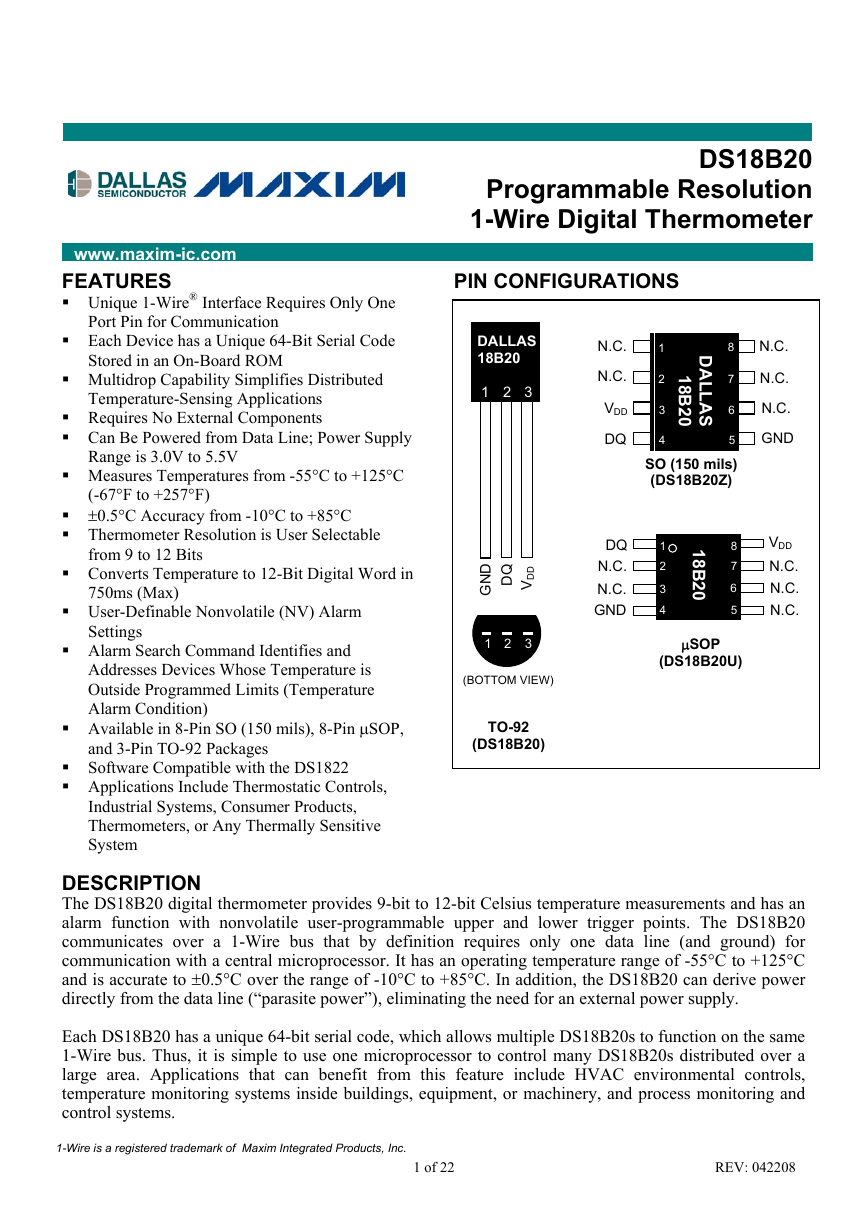

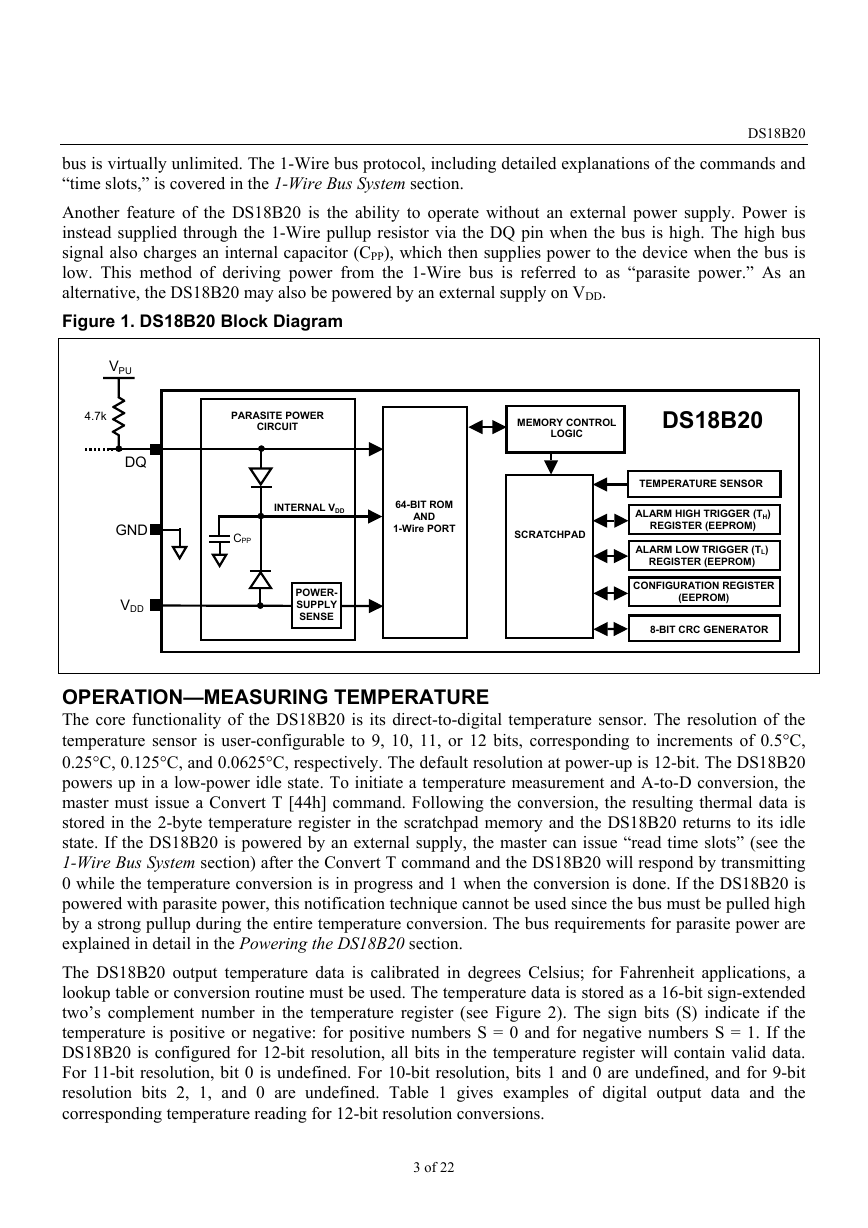
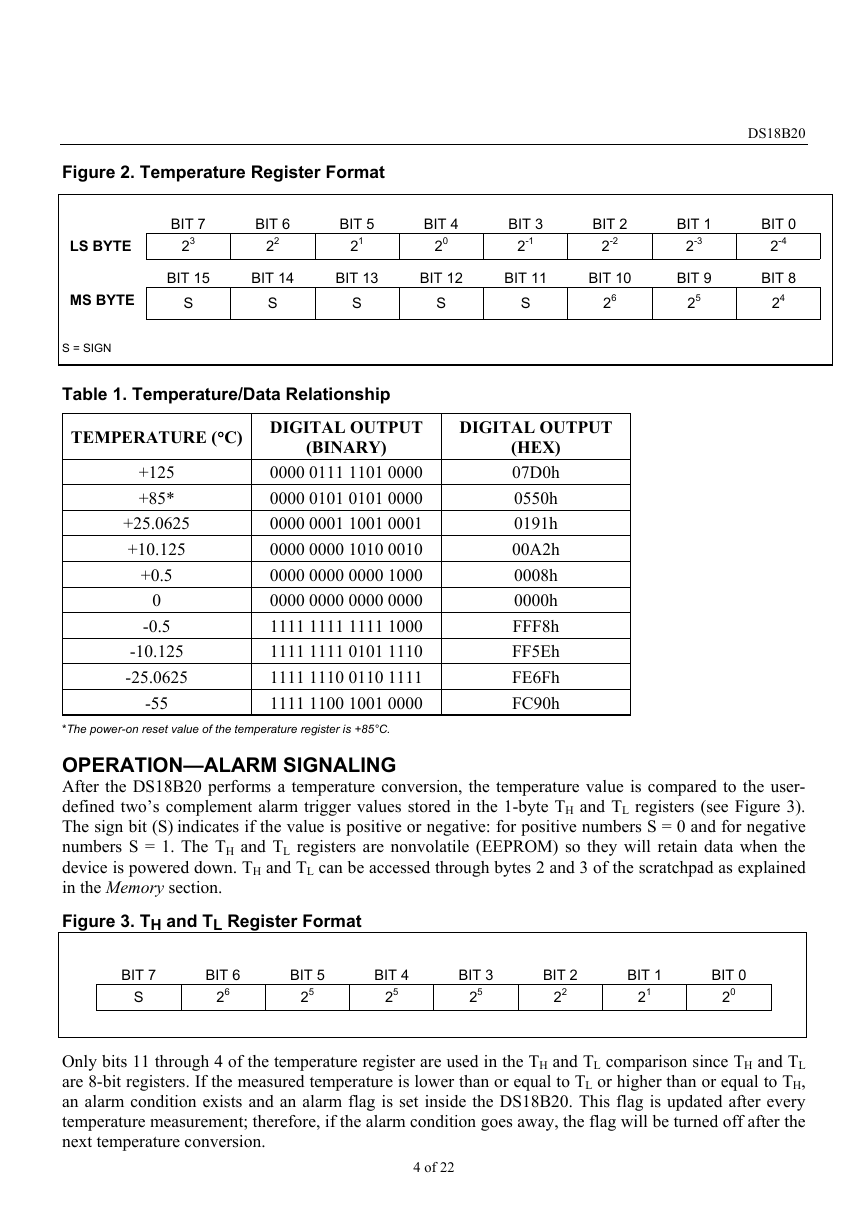
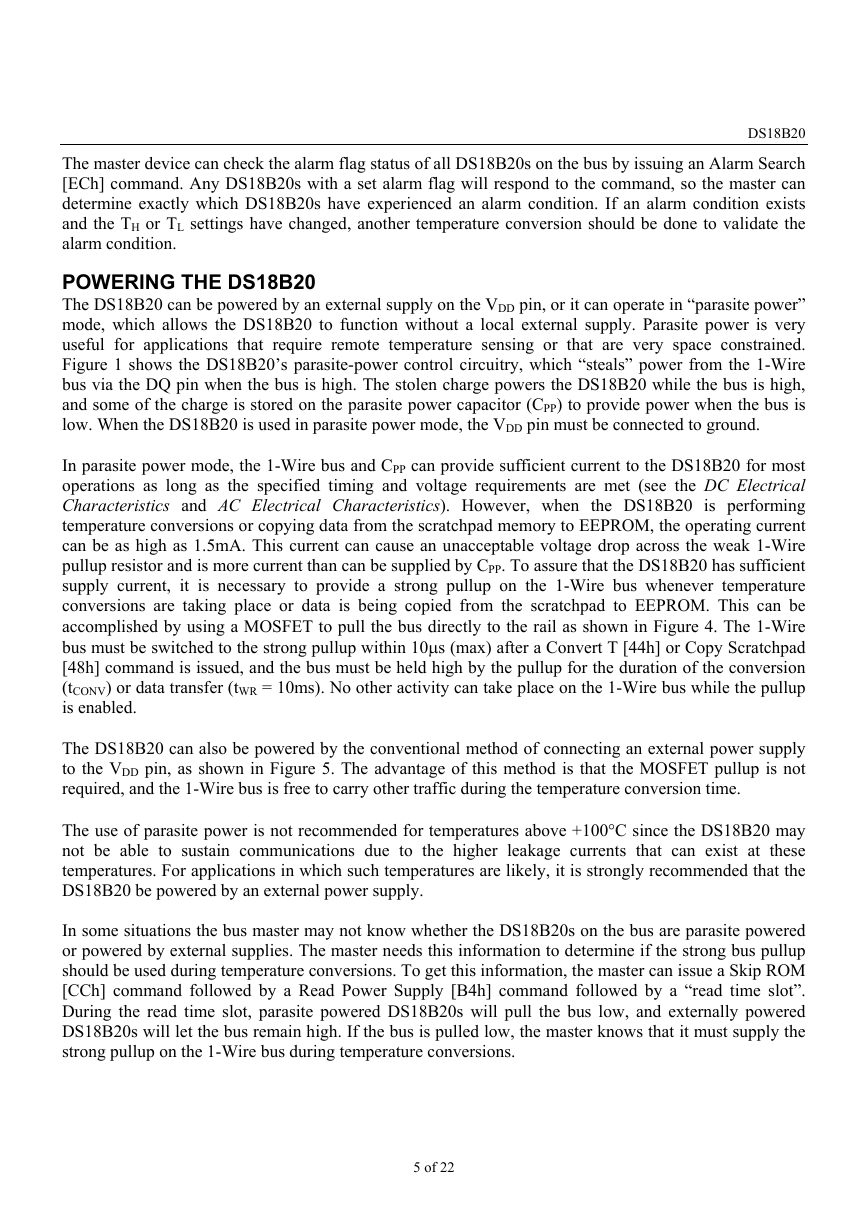
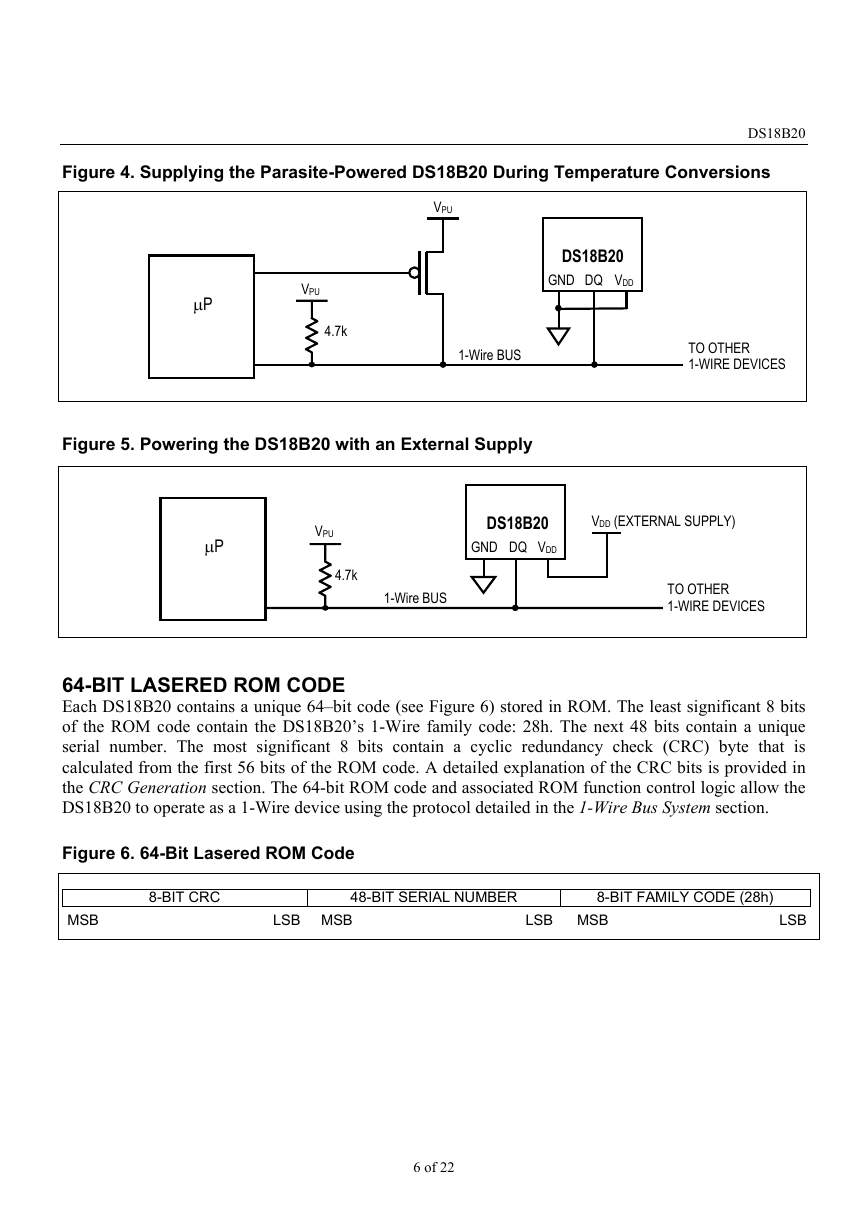










 2023年江西萍乡中考道德与法治真题及答案.doc
2023年江西萍乡中考道德与法治真题及答案.doc 2012年重庆南川中考生物真题及答案.doc
2012年重庆南川中考生物真题及答案.doc 2013年江西师范大学地理学综合及文艺理论基础考研真题.doc
2013年江西师范大学地理学综合及文艺理论基础考研真题.doc 2020年四川甘孜小升初语文真题及答案I卷.doc
2020年四川甘孜小升初语文真题及答案I卷.doc 2020年注册岩土工程师专业基础考试真题及答案.doc
2020年注册岩土工程师专业基础考试真题及答案.doc 2023-2024学年福建省厦门市九年级上学期数学月考试题及答案.doc
2023-2024学年福建省厦门市九年级上学期数学月考试题及答案.doc 2021-2022学年辽宁省沈阳市大东区九年级上学期语文期末试题及答案.doc
2021-2022学年辽宁省沈阳市大东区九年级上学期语文期末试题及答案.doc 2022-2023学年北京东城区初三第一学期物理期末试卷及答案.doc
2022-2023学年北京东城区初三第一学期物理期末试卷及答案.doc 2018上半年江西教师资格初中地理学科知识与教学能力真题及答案.doc
2018上半年江西教师资格初中地理学科知识与教学能力真题及答案.doc 2012年河北国家公务员申论考试真题及答案-省级.doc
2012年河北国家公务员申论考试真题及答案-省级.doc 2020-2021学年江苏省扬州市江都区邵樊片九年级上学期数学第一次质量检测试题及答案.doc
2020-2021学年江苏省扬州市江都区邵樊片九年级上学期数学第一次质量检测试题及答案.doc 2022下半年黑龙江教师资格证中学综合素质真题及答案.doc
2022下半年黑龙江教师资格证中学综合素质真题及答案.doc